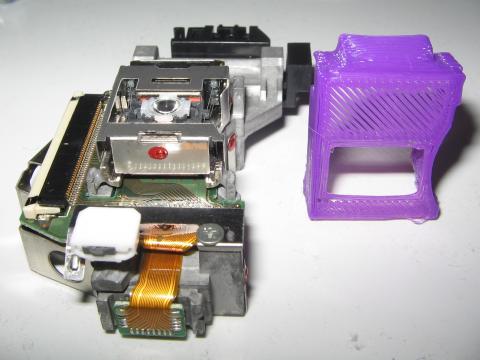La semana pasada hicimos más pruebas para enfocar el láser.
La idea original consistía en enfocar el láser en cuatro puntos de enfoque que tienen un material reflectante y que van pegados bajo el cristal. El robot mueve automáticamente el láser a esos puntos de enfoque y toma cuatro medidas de enfoque. Entonces utiliza las medidas para extrapolar los datos al resto de la PCB, y así enfocar con precisión el láser mientras imprime el circuito. Parecía viable pero tuvimos algunos problemas con el espesor del vidrio. Estábamos usando un vidrio de 2mm y tuvimos que cambiar a vidrio de 1,5mm que funciona mejor. Pero incluso con el nuevo vidrio no estábamos satisfechos porque los puntos de enfoque estaban demasiado lejos de las esquinas de la PCB y las medidas de enfoque no eran muy precisas.
Si queríamos mejorar la precisión de enfoque tendríamos que enfocar en las esquinas de la PCB. Esto no es un problema porque la PCB es bastante reflectante como para enfocar directamente en ella, pero como siempre ocurre en estos casos aparecieron efectos secundarios. Primero al enfocar en las esquinas dejamos cuatro manchas en el dry-film porque el láser UV lo sensibiliza en esos lugares. Segundo tenemos que enfocar a través del cristal y del solar-film. Recordad que utilizábamos el solar-film para filtrar los rayos UV y proteger la PCB contra el efecto "halo" producido por la lente del pickup. El filtro funciona muy bien mientras imprimimos pero disminuye el rendimiento del láser cuando enfocamos. Así que estábamos de nuevo en un callejón sin salida.
Pero hemos encontrado una solución: utilizar el láser rojo.
El PHR-803T es fantástico. Tiene tres diodos láser: uno en la banda infrarroja para la lectura de CDs, otro en la banda roja para DVDs y otro en la banda de UV cercana para HD-DVD/Blu-ray, que es el que usamos para imprimir. Cuando hackeamos el pickup no prestamos mucha atención a los láser rojos porque estábamos centrados en sensibilizar el dry-film con luz UV, pero creo que ahora vamos a usar el rojo para enfocar.

Usar el láser rojo para enfocar tiene algunas ventajas: